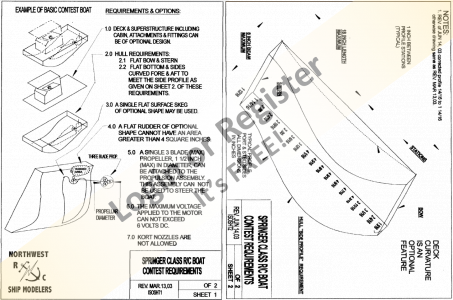Join Us On Social Media!
Guess I will be building a Springer
7 Posts · 3 Followers · 4 Photos · 19 Likes
Began 1 month ago by
Follow This Thread
Not currently following
> Click to follow
> Click to follow
Latest Post 1 month ago by
( Newest Posts Shown First )
📝 Guess I will be building a Springer
19 Views · 2 Likes
Country: 🇬🇧 United Kingdom
Online: 9 hours ago
Online: 9 hours ago
Lew, thanks for the interesting article and your comments.
I am not too bothered by the Springer specifications as there are no other springers in our club. As usual I have got a bit sidetracked during my research😁 and due to available materials started on another pusher tug while I get the materials for the one in this blog.
I am not too bothered by the Springer specifications as there are no other springers in our club. As usual I have got a bit sidetracked during my research😁 and due to available materials started on another pusher tug while I get the materials for the one in this blog.
▲
⟩⟩
hermank
LewZ
📝 Guess I will be building a Springer
22 Views · 4 Likes
Country: 🇺🇸 United States
Online: 10 hours ago
Online: 10 hours ago
Info on the Springer class push-boats copied and pasted below. I you want to follow the rules, here they are. (many don't, probably not knowing these specifications exist.) There reason for the rules are to make the boat a one design so they are competitive. However, at the bottom I list a few objections to the rules, especially those that make no sense. Here they are:
"I belong to the Northwest R/C Ship Modelers (NWRCSM) boat club. This club is located in Puget Sound area of Washington State and is currently celebrating its 25th anniversary, with nearly 100 members. The club is dedicated to all types of model R/C boats with many tugboats and a few sailboats. Virtually all the boats are electric powered, with a few
steamers. Gas motors are expressly prohibited from club events.
The original Springer was designed in 1998 by Dave & John Springer. John, a NWRCSM club member, designed the boat after a workboat he originally saw in Alaska. The hull lines were simple and he took a very straightforward approach to building his first boat. It soon became popular and many members started to plan for their own “Springer”. To develop a “club boat” some basic rules were set so the various models would perform similarly on the water. No limitations or guidelines were placed on the appearance of the boat above the waterline. This model soon become very popular and many club members have at least one “Springer”. The concept also traveled south to the San Francisco Club as they expanded on the performance related restrictions and insist that the boat look like a real boat. No hot tubs or outhouses are allowed in their rules. This club also developed a polo version of the Springer and started to have rough and tumble Polo matches. The Puget Sound group has since picked up on this theme as well.
The club has two special Springer events each year where competition is open only to these Springer boats. These are small workboats that are relatively easy and inexpensive to build. I have been a member of the club for two years and when it was
decided to build Springers that would also play water polo I decided to get into the act and finally build a Springer.
I had built a sailboat from a kit and models of the tugboats Henry Foss and Tidewater from scratch so I felt that a Springer would be no real challenge. In the following paragraphs I will describe how I built my Springer and the decisions and challenges I faced. It is truly inexpensive and reasonably easy to build but there are some interesting considerations that I
had not expected.
The Basic Springer specifications are very simple. The basic boat is to be 18 inches long and 8 inches wide with a flat bottom. The other specifications are:
A 6-volt battery shall power the motor.
The propeller shall be 3 bladed and no larger than 40mm in diameter.
The rudder shall be a maximum area of 4 square inches.
The complete requirements are available on the club WEB site (www.shipmodelers.com).
The cabin and other features on deck will be left to the discretion of the builder.
Hull – Hull profile to conform to original Springer profile. Beam is 8 inches” +- .062, Length 18 inches +- .125”
Rudder – 4 in2 maximum. Single piece construction (salmon tail allowed).
Drive – Single shaft, direct or reduced drive open propeller. (No Kort nozzles or Z drives).
Propeller – 3 blades, maximum diameter of 40 mm.
Motor Type – Builders option.
Motor Battery – 6 volts maximum.
Gearing – Builders Option.
For the water polo version Springer the following specifications were added:
Rudder Shoe - All boats must be equipped with a rudder shoe that extends from the skeg or hull bottom to the rudder shaft.
The shoe must be 1/16 inch or less from the rudder in order to prevent the rudder or propeller from snagging a ¼ inch rope used for course boundaries.
Flag Holder – 1 inch 3/32 inch brass tube centered on stern approx. ¼ inch from edge.
Push Knees – ¾ inch wide, minimum 2 ½ inches in height measured from deck, mounted on 7-inch centers.
Door stops – Removable spring type mounted on each knee at or below deck level.
Weight – 8 ½ lbs. minimum."
In my opinion some of the rules are nonsense. Take for example the 6V battery. 7.2V hobby batteries are quite common, much more that the 6V wet or dry cells. Being the builder has the option to change the gearing and there are so many different motors out there the only thing would be to have a sensible limit on the voltage. Same with the flagpole on the stern. One particular item is the dimensions for the push knees. Being I build my springer to scale I follow the design of the real boat. I'm sure there are a few other quirky rules as well.
I also attached a scale crew figure comparison page based on the Springer rules hull dimensions. Having built four Springers, I found the 1/16 to 1/18 scale figure and related deck structure compatible with the vast majority of the real "truckable" push boats I have researched.
If you are based in North America I recommend the Zippkits kit. The low cost, quality and laser precut wood greatly reduces labor time. You can see my builds in "My Harbor" on this site.
Lew



"I belong to the Northwest R/C Ship Modelers (NWRCSM) boat club. This club is located in Puget Sound area of Washington State and is currently celebrating its 25th anniversary, with nearly 100 members. The club is dedicated to all types of model R/C boats with many tugboats and a few sailboats. Virtually all the boats are electric powered, with a few
steamers. Gas motors are expressly prohibited from club events.
The original Springer was designed in 1998 by Dave & John Springer. John, a NWRCSM club member, designed the boat after a workboat he originally saw in Alaska. The hull lines were simple and he took a very straightforward approach to building his first boat. It soon became popular and many members started to plan for their own “Springer”. To develop a “club boat” some basic rules were set so the various models would perform similarly on the water. No limitations or guidelines were placed on the appearance of the boat above the waterline. This model soon become very popular and many club members have at least one “Springer”. The concept also traveled south to the San Francisco Club as they expanded on the performance related restrictions and insist that the boat look like a real boat. No hot tubs or outhouses are allowed in their rules. This club also developed a polo version of the Springer and started to have rough and tumble Polo matches. The Puget Sound group has since picked up on this theme as well.
The club has two special Springer events each year where competition is open only to these Springer boats. These are small workboats that are relatively easy and inexpensive to build. I have been a member of the club for two years and when it was
decided to build Springers that would also play water polo I decided to get into the act and finally build a Springer.
I had built a sailboat from a kit and models of the tugboats Henry Foss and Tidewater from scratch so I felt that a Springer would be no real challenge. In the following paragraphs I will describe how I built my Springer and the decisions and challenges I faced. It is truly inexpensive and reasonably easy to build but there are some interesting considerations that I
had not expected.
The Basic Springer specifications are very simple. The basic boat is to be 18 inches long and 8 inches wide with a flat bottom. The other specifications are:
A 6-volt battery shall power the motor.
The propeller shall be 3 bladed and no larger than 40mm in diameter.
The rudder shall be a maximum area of 4 square inches.
The complete requirements are available on the club WEB site (www.shipmodelers.com).
The cabin and other features on deck will be left to the discretion of the builder.
Hull – Hull profile to conform to original Springer profile. Beam is 8 inches” +- .062, Length 18 inches +- .125”
Rudder – 4 in2 maximum. Single piece construction (salmon tail allowed).
Drive – Single shaft, direct or reduced drive open propeller. (No Kort nozzles or Z drives).
Propeller – 3 blades, maximum diameter of 40 mm.
Motor Type – Builders option.
Motor Battery – 6 volts maximum.
Gearing – Builders Option.
For the water polo version Springer the following specifications were added:
Rudder Shoe - All boats must be equipped with a rudder shoe that extends from the skeg or hull bottom to the rudder shaft.
The shoe must be 1/16 inch or less from the rudder in order to prevent the rudder or propeller from snagging a ¼ inch rope used for course boundaries.
Flag Holder – 1 inch 3/32 inch brass tube centered on stern approx. ¼ inch from edge.
Push Knees – ¾ inch wide, minimum 2 ½ inches in height measured from deck, mounted on 7-inch centers.
Door stops – Removable spring type mounted on each knee at or below deck level.
Weight – 8 ½ lbs. minimum."
In my opinion some of the rules are nonsense. Take for example the 6V battery. 7.2V hobby batteries are quite common, much more that the 6V wet or dry cells. Being the builder has the option to change the gearing and there are so many different motors out there the only thing would be to have a sensible limit on the voltage. Same with the flagpole on the stern. One particular item is the dimensions for the push knees. Being I build my springer to scale I follow the design of the real boat. I'm sure there are a few other quirky rules as well.
I also attached a scale crew figure comparison page based on the Springer rules hull dimensions. Having built four Springers, I found the 1/16 to 1/18 scale figure and related deck structure compatible with the vast majority of the real "truckable" push boats I have researched.
If you are based in North America I recommend the Zippkits kit. The low cost, quality and laser precut wood greatly reduces labor time. You can see my builds in "My Harbor" on this site.
Lew



▲
⟩⟩
Chum444
Ronald
philcaretaker
hermank
Lew Zee (LewsModelBoats.org)
📝 Guess I will be building a Springer
46 Views · 1 Like
Country: 🇬🇧 United Kingdom
Online: 12 hours ago
Online: 12 hours ago
Ed. My 20Watt Ortur has a 350 x 350 working area
▲
⟩⟩
hermank
If it don't fit, use a hammer to make it fit....
📝 Guess I will be building a Springer
50 Views · 2 Likes
Country: 🇬🇧 United Kingdom
Online: 9 hours ago
Online: 9 hours ago
Nick, you get a pdf and 2 Lightburn files. The Lightburn files can be pushed straight to the cutter but I will have to manipulate positions to suit the size of my laser cutter
▲
⟩⟩
hermank
Nickthesteam
📝 Guess I will be building a Springer
49 Views · 1 Like
Country: 🇬🇧 United Kingdom
Online: 12 hours ago
Online: 12 hours ago
Do you get a dxf file or do you have to trace the parts into a cad progra
▲
⟩⟩
hermank
If it don't fit, use a hammer to make it fit....
📝 Guess I will be building a Springer
50 Views · 1 Like
Country: 🇬🇧 United Kingdom
Online: 14 minutes ago
Online: 14 minutes ago
I haven't seen any springer tugs down the club Ed, but I haven't been down there very often over the last couple of years, there must be some I guess?
Will be interesting to see you cut it out and build it.
Chris
Will be interesting to see you cut it out and build it.
Chris
▲
⟩⟩
hermank
Scratch building 7 Faireys at a scale of 1:12
📝 Guess I will be building a Springer
54 Views · 8 Likes
Country: 🇬🇧 United Kingdom
Online: 9 hours ago
Online: 9 hours ago
I found these files for laser cutting the parts for a springer while browsing the internet. The first really useful templates for laser cutting so I had to buy them.
Had enough of cutting key rings and the like and about time to use my laser cutter for the reason I bought it.

Had enough of cutting key rings and the like and about time to use my laser cutter for the reason I bought it.

▲
⟩⟩
premecekcz
AlessandroSPQR
IanL1
hermank
BarryS
jumpugly
Nickthesteam
ChrisF





 Captain
Captain United Kingdom
United Kingdom Vice Admiral
Vice Admiral Rear Admiral
Rear Admiral
















